- Home
- Don Pendleton
Mind to Mind
Mind to Mind Read online
MIND TO MIND
Ashton Ford, Psychic Detective
Don Pendleton
Creator of
The Executioner: Mack Bolan Series
and
Joe Copp Private Eye Thrillers
Books by Don Pendleton
Fiction
The Executioner, Mack Bolan Series
The Joe Copp Mystery Series: Copp for Hire; Copp on Fire; Copp in Deep; Copp in the Dark; Copp on Ice; Copp in Shock.
The Ashton Ford Mystery Series: Ashes to Ashes; Eye to Eye; Mind to Mind; Life to Life; Heart to Heart; Time to Time.
Fiction written with Linda Pendleton
Roulette
Comics by Don and Linda Pendleton
The Executioner, War Against the Mafia
Nonfiction Books by Don Pendleton
A Search for Meaning From the Surface of a Small Planet
Nonfiction Books by Don and Linda Pendleton
To Dance With Angels
Whispers From the Soul
The Metaphysics of the Novel
The Cosmic Breath
Mind to Mind: Ashton Ford, Psychic Detective
Copyright © 1987 by Don Pendleton, All rights reserved. Published with permission of Linda Pendleton.
Cover design by Linda Pendleton and Judy Bullard
This is a work of fiction. Any similarity to actual persons, groups, organizations, or events is not intended and is entirely coincidental.
No part of this book may be reproduced or transmitted in any form or by any means, graphic, electronic, or mechanical, including photocopying, recording, taping, or by any information storage retrieval system, without the written permission of Linda Pendleton.
Smashwords Edition, License Notes:
This edition is licensed for your personal enjoyment only. This ebook may not be re-sold or given away to other people. If you would like to share this book with another person, please purchase an additional copy for each person. If you are reading this book and did not purchase it, or it was not purchased for your use only, then please return to Smashwords.com and purchase your own copy. Thank you for respecting the hard work and rights of the author.
Don Pendleton Books
The Ashton Ford novels
Ashes to Ashes
Eye to Eye
Mind to Mind
Life to Life
Heart to Heart
Time to Time
The Joe Copp novels by Don Pendleton
Copp for Hire
Copp on Fire
Copp in Deep
Copp in the Dark
Copp in Shock
The Executioner: Mack Bolan Series
Fiction written with Linda Pendleton
Roulette
Executioner: War Against the Mafia, Comic
Nonfiction
A Search for Meaning
Nonfiction with Linda Pendleton
To Dance With Angels
Whispers From the Soul
Metaphysics of the Novel
The Cosmic Breath: Metaphysical Essays
For Linda, who gave me the title in an airport, and whose mind touches mine every day in all the gentle ways.
Mens agitat molem.
(Mind moves matter.)
—Virgil (Aeneid, vi)
The conscious mind may be compared
to a fountain playing in the sun
and falling back into the great
subterranean pool of the subconscious
from which it rises.
—Sigmund Freud
Author’s Note
To My Readers:
Ashton Ford will come as something of a surprise to those of you who have been with me over the years. This is not the same type of fiction that established my success as a novelist; Ford is not a gutbuster and he is not trying to save the world from anything but its own confusion. There are no grenade launchers or rockets to solve his problems and he is more of a lover than a fighter.
Some have wondered why I was silent for so many years; some will now also wonder why I have returned in such altered form. The truth is that I had said all I had to say about that other aspect of life. I have grown, I hope, both as a person and as a writer, and I needed another vehicle to carry the creative quest. Ashton Ford is that vehicle. Through this character I attempt to understand more fully and to give better meaning to my perceptions of what is going on here on Planet Earth, and the greatest mystery of all the mysteries: the why of existence itself.
Through Ford I use everything I can reach in the total knowledge of mankind to elaborate this mystery and to arm my characters for the quest. I try to entertain myself with their adventures, hoping that what entertains me may also entertain others—so these books, like life itself, are not all grim purpose and trembling truths. They are fun to write; for some they will be fun to read. To each of those I dedicate the work.
~Don Pendleton
Chapter One: In the Silence
It was an eerie piece of business. This "Jane Doe" was very pretty, apparently in her late twenties to early thirties, very alert and responsive. I was convinced that she knew who she was and where she was—and why she was the way she was—but there was no way for her to communicate any of that. This Jane Doe, you see, had only half a brain. The left hemisphere of her cerebral cortex had been surgically removed after suffering massive damage when someone had literally tried to beat her brains out with a crowbar. The right side of her body was totally paralyzed. Not only was there no movement possible on that side, there was also no feeling and apparently no mental awareness of the right arm and leg; she did not even recognize them as her own. She was responsive to voices and other sounds but possessed virtually no language capability. The eyes, though alert and expressive, remained extremely deviated to the left; to maintain eye contact I had to keep myself positioned to her left side, but she seemed unaware of the problem.
My friend Jim Cochran had asked me to drop in and see the lady. Jim is a cop. He was in charge of the case for LAPD. Six weeks had passed since the attack on this young woman. She was fully recovered from the surgery—as "recovered" as anyone expected her to get—but she remained unidentified, and Jim did not know even where to begin his investigation. The nude, savagely battered victim had been discovered beside the Hollywood Freeway, obviously dumped there after the attack and thought to be dead. The weapon, a heavy crowbar, was found a few feet away. Photographs of the victim had been circulated nationwide. No one had come forward to identify her, and apparently she was unable to identify herself.
I had worked with the police before—missing persons and homicide cases—with pretty good success. At such times I am usually referred to as a "psychic consultant," though really I am not at all sure what it is I do. I was trained for intelligence work by the U.S. Navy. I also have played around with various mental disciplines over the years, and I have had an active interest all my life in philosophy and psychology in general, metaphysics in particular, and I have a pretty good grounding in the theoretical sciences. So I don't really know what the hell I do with my head in cases like this one.
I guess what I do, basically, is simply to expose myself to the problem—whatever it is—and flow with the reaction. Maybe it is psychic. Just don't confuse me with Mandrake the Magician.
Anyway, I went to see Jim Cochran's "Jane Doe"—and what I did with my head, that time, was next to nothing. I mentioned the eeriness of the encounter, but there was more to it than that. I felt damn near overwhelmed by this young woman's misfortune. And mad. Yeah. I felt mad as hell. I know, I know—a "professional" is not supposed to get emotionally involved with his subject. But this woman had really been wasted, and very savagely so. Maybe I am just not professional enough, because I cannot handle this sort of thing wi
th cold detachment.
Consider her situation and put yourself there if you can. You can think and you can remember. You can smell the flowers outside your window and see the birds flying past. You can feel joy and anger, love and fear—but all those experiences and all those feelings must remain forever locked inside your damaged head because you have no way to think with words.
Words ... yes, how important are words to that unique consciousness that we identify with the human experience. Most all of man that is peculiarly man was arrived at through the gift of language. Take away the gift and what is left of the man? Take away the words and the ability to reason mathematically and what is left of science? Without science, what is technology? Without technology, what is a civilization?
And what, dear God, was left of Jane Doe? Though she could cuss with anger and frustration, hum a tune, even sing a nursery rhyme with pretty fair diction, she could not summon the sound of her own name. She could draw a crude picture of her home but find no clue to the street address or city or even nation.
The problem, you see, was that Jane Doe was left with only a "subconscious" mind. That is what we have always called it, anyway. Lately we have heard it called "the right brain." And that is what Jane was left with. The right brain, in most people, provides that part of the human personality that deals in creativity, emotion, feelings, visual images, intuition. It does not deal with language or mathematics, not after the age of about five or six when the process called "specialization" seats the objective faculties in the left hemisphere.
If Jane Doe's misfortune had occurred when she was five years old, the right hemisphere would have gone on to develop on its own all the left hemisphere functions, and she would have grown up entirely normal. But for a calamity of this nature to befall a mature person ... well, that half a brain is exactly that, half a brain, incapable of reconstituting itself into a fully functioning organ of human consciousness.
So ... was Jane Doe still fully human?
This was the eerie part, I guess. I had the same feeling once at the San Diego Zoo while locked in a staring match with one of the gorillas. The old fellow was looking me straight in the eye, and I had the strongest feeling that we were communicating somehow; that a mind-to-mind transfer was happening there. It shook me. I still think about the experience from time to time.
And I had that same eerie feeling while my eyes were locked with Jane Doe's. I got no pictures, no images of any kind, just that feeling of energy surging between the minds. It shivered me, spooked me. There was a person in there somewhere, locked behind those eyes. But how "fully human" a person?
I did not—could not—stay long. Jim jumped straight down my throat the instant we got outside. "What the hell kind of interview was that?" he growled, very unhappy with me.
"Sony," I told him. "I can't help you with this one."
"Sorry, my ass! You didn't even try!"
I said, “Look, you asked me to give her a look. Okay. I gave her a look. And I'm telling you I can't help you.”
He leaned against the wall, lit a cigarette, said very quietly, "Spooked you, didn't she?"
I admitted it.
After a moment of silence he said, "Well, I'll grant you, she may have the intelligence of a three-year-old child, but I believe she understands what we want, and I believe there's a way to get it out of her."
"Give it some rest," I suggested. "She'll improve with therapy. They're doing some amazing—"
"Oh, bullshit, Ash," he interrupted impatiently. "She hasn't moved an inch after four weeks of therapy. Chances are she never will. There just isn't much left to her. But, dammit, she's alive, and I think she can finger the guy that did it. I want that guy, Ash. I really want that guy."
I said, "Yeah. I understand how you feel. But I ..."
After a moment he said, "You didn't even try, Ash."
I told him, "Well ... let me sleep on it. Call you tomorrow."
He said, "No fee, pal, for today. You didn't earn it."
I knew I hadn't earned it. I had not come for the fee, anyway. I came because a friend asked me to. That did not, however, obligate me to become involved in the case. And I really did not want to do so. I watched my friend the cop walk away, then I lit a cigarette while wrestling with my conscience. Could I walk away from this one? Sure I could. The same way I had walked away from the San Diego Zoo. I had long ago decided that some things were just better left alone. I did not conduct séances or otherwise attempt communications with "the dead." I did not "exorcise demons," and I had no truck with haunted houses. I did not attempt mental telepathy with dolphins or gorillas. So why should I ...?
That line of thought was interrupted by the sudden appearance of Jane Doe herself. A candy striper pushed her wheelchair through the doorway and on toward the terrace. I was standing off to the side, sucking my cigarette, and Jane's left-deviated eyes swept me as she passed by. I experienced the eerie feeling again, a sort of tingle deep within the brain. Or was it deep within the right brain? Certainly it was something nonverbal, almost primitive ... a shiver of the soul?
Could that be the explanation? Not just this time but for all the eerie, shivery, nonverbal encounters of the mind? Had Jane Doe's nonverbal right brain just been in communication with my nonverbal right brain?
Perhaps it is true that some things are better left alone. But, after all, this was County General Hospital, not the San Diego Zoo—and that was a human being over there, not a gorilla. And I had the damnedest, most shivery feeling that this human being was screaming at me in the silence.
I could not walk away from that.
Chapter Two: Connecting
I took over from the candy striper and pushed the wheelchair across the terrace, down the ramp, onto the lawn. It was a nice day, a bit warm but with gentle, cooling breezes. There were squirrels out here and a variety of birds, and there was a sweet smell to the air. I made no attempt to connect with her verbally, since I knew that she could not respond in kind, and I was not sure that she could deal intellectually with anything I might say, anyway. Obviously she could and did respond to simple command statements, such as, "Raise your arm—blink your eyes," and so forth, but much of that response could be coming directly from the brain stem, so it did not necessarily indicate intellectual activity.
She seemed to be enjoying the communion with nature, though, appreciatively sniffing the air and cocking the good left ear to the songbirds. And she seemed totally at ease with me. I began softly whistling "Summertime" as I moved her toward the trees. She swiveled her head to look at me and smiled with the left side of her face, began humming the tune in perfect key with my whistling. As I was launching into the fourth repeat of the chorus, she laughed softly and reached back with her good left hand to touch me—and God, did it touch me!—as if to say, "That's enough of that."
I wheeled her to a good level spot where the grass was thick and dry, took the blanket off her lap and spread it on the ground, then moved her onto the blanket and left it up to her to find the most comfortable position. That proved a bit awkward. She would shift about, glare at the uncooperative side of her body with something like bewilderment, push at the dead leg as though trying to shoo it away from her, try again and again without much improvement. I was reminded of a dog I once had who liked to lie down with a stuffed toy but never could seem to get the darned thing positioned properly against his body—and I was aware of what was happening with Jane Doe. She had no sensory connection to that dead leg. It was just a "thing" that always seemed to be in her way.
I let her fight it alone for a couple of minutes before I knelt beside her and lent a hand. It then became obvious that she knew what she wanted to do; with my help she ended up lying on her good left side, arm bent and elbow supporting the torso at a slight elevation, legs drawn in a loose fetal curl. I lay down facing her in a mirror-image attitude, with plenty of separation between us. Because her eyes were fixed leftward, she had to swivel her head toward the right shoulder in order to look at me.
I positioned her head straight on with one hand and said to her, "Look at me." Her head fought my restraining hand, trying to comply, but I held firmly and kept repeating, "Look at me."
The only evidence that she was trying to do so was in the muscles of the good left side of her face as she squinted, scowled, twitched the cheek, curled the lip. After about twenty seconds of that she exploded with a frustrated expletive: "Shit!"
I laughed. She laughed. I released her for a moment, showed her how I did it with my own eyes, positioned her straight on again, said, "Now, dammit, look at me."
Again she yelled, "Shit!" But there was a movement there—a twitch, anyway. We kept at it. After a minute or so she was starting to get the hang of it, but I was not sure that the eyes were tracking together. Curious thing about the visual fields. Each eye has two of them, left and right field in each eye, each field wired to the corresponding control side of the brain. Right brain, left visual field; left brain, right visual field. Since Jane Doe had no left brain, she also had no right visual field in either eye. Which would indicate, I gathered, that she could not take in a whole image with a single glance; she would have to "scan" the object with the single field available to her and reconstruct the fractured pictures thus gained into a whole image. I had already noticed that she "saw" in somewhat this fashion, evidenced by a slight quivering of the eyes while locked leftward.

 Wild Card
Wild Card Warrior's Edge
Warrior's Edge Blood Vortex
Blood Vortex Lethal Vengeance
Lethal Vengeance Killing Kings
Killing Kings Cold Fury
Cold Fury Righteous Fear
Righteous Fear Cyberthreat
Cyberthreat Stealth Assassin
Stealth Assassin Critical Exposure
Critical Exposure Miami Massacre te-4
Miami Massacre te-4 Terrible Tuesday
Terrible Tuesday Dying Art
Dying Art Jungle Hunt
Jungle Hunt Sicilian Slaughter
Sicilian Slaughter Throw Down
Throw Down Miami Massacre
Miami Massacre Sudden Death
Sudden Death Panic in Philly
Panic in Philly Savage Fire
Savage Fire Nightmare in New York te-7
Nightmare in New York te-7 Omega Cult
Omega Cult Sabotage
Sabotage Viral Siege
Viral Siege War Tactic
War Tactic Thunder Down Under
Thunder Down Under Haitian Hit
Haitian Hit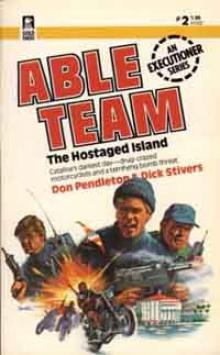 The Hostaged Island at-2
The Hostaged Island at-2 Fireburst
Fireburst The Killing Urge
The Killing Urge Assault
Assault Ashes To Ashes: Ashton Ford, Psychic Detective
Ashes To Ashes: Ashton Ford, Psychic Detective Flight 741
Flight 741 Eternal Triangle
Eternal Triangle Frontier Fury
Frontier Fury Meltdown te-97
Meltdown te-97 Chicago Wipeout
Chicago Wipeout Command Strike
Command Strike Nightmare Army
Nightmare Army Ivory Wave
Ivory Wave Combat Machines
Combat Machines Silent Threat
Silent Threat Resurrection Day
Resurrection Day Perilous Cargo
Perilous Cargo Syrian Rescue
Syrian Rescue Arizona Ambush te-31
Arizona Ambush te-31 Siege
Siege Line of Honor
Line of Honor Lethal Risk
Lethal Risk Blood Testament te-100
Blood Testament te-100 Soviet Specter
Soviet Specter Arizona Ambush
Arizona Ambush Fatal Prescription
Fatal Prescription Deep Recon
Deep Recon Border Sweep
Border Sweep Life to Life
Life to Life Ballistic
Ballistic Hellbinder
Hellbinder Time to Time: Ashton Ford, Psychic Detective (Ashton Ford Series Book 6)
Time to Time: Ashton Ford, Psychic Detective (Ashton Ford Series Book 6) The Violent Streets te-41
The Violent Streets te-41 The Libya Connection te-48
The Libya Connection te-48 Cartel Clash
Cartel Clash Whipsaw te-144
Whipsaw te-144 Blood Rites
Blood Rites Triangle of Terror
Triangle of Terror Betrayed
Betrayed San Diego Siege
San Diego Siege Death Minus Zero
Death Minus Zero Arctic Kill
Arctic Kill Mind to Mind: Ashton Ford, Psychic Detective
Mind to Mind: Ashton Ford, Psychic Detective Blood Heat Zero te-90
Blood Heat Zero te-90 Dead Man's Tale
Dead Man's Tale Sunscream te-85
Sunscream te-85 Ice Wolf
Ice Wolf Deadly Contact
Deadly Contact The Cartel Hit
The Cartel Hit Tower of Terror at-1
Tower of Terror at-1 Conflict Zone
Conflict Zone Patriot Strike
Patriot Strike Point Blank
Point Blank Rogue Force
Rogue Force Patriot Play
Patriot Play Cold Judgment
Cold Judgment Contagion Option
Contagion Option Sicilian Slaughter te-16
Sicilian Slaughter te-16 Dragon Key
Dragon Key Terminal Velocity
Terminal Velocity Vegas Vendetta
Vegas Vendetta Ashes To Ashes
Ashes To Ashes Blood of the Lion
Blood of the Lion Ballistic Force
Ballistic Force Desperate Cargo
Desperate Cargo Detroit Deathwatch te-19
Detroit Deathwatch te-19 Nightmare in New York
Nightmare in New York Killpath
Killpath Executioner 056 - Island Deathtrap
Executioner 056 - Island Deathtrap Battle Cry
Battle Cry Don Pendleton - Civil War II
Don Pendleton - Civil War II Copp In The Dark, A Joe Copp Thriller (Joe Copp Private Eye Series)
Copp In The Dark, A Joe Copp Thriller (Joe Copp Private Eye Series) China Crisis (Stony Man)
China Crisis (Stony Man) Code of Dishonor
Code of Dishonor Firebase Seattle
Firebase Seattle Hard Targets
Hard Targets Domination Bid
Domination Bid Kill Squad
Kill Squad Slayground
Slayground Poison Justice
Poison Justice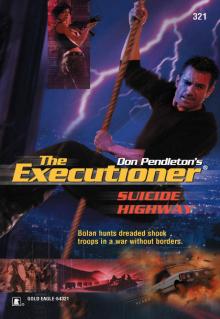 Suicide Highway
Suicide Highway Copp In Deep, A Joe Copp Thriller (Joe Copp Private Eye Series)
Copp In Deep, A Joe Copp Thriller (Joe Copp Private Eye Series) Prairie Fire
Prairie Fire Ninja Assault
Ninja Assault Death Metal
Death Metal Blood Run
Blood Run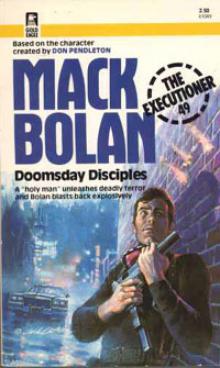 Doomsday Disciples te-49
Doomsday Disciples te-49 Breakout
Breakout Caribbean Kill te-10
Caribbean Kill te-10 Fire Eaters
Fire Eaters Hawaiian Hellground
Hawaiian Hellground Baltimore Trackdown te-88
Baltimore Trackdown te-88 Threat Factor
Threat Factor Don Pendleton's Science Fiction Collection, 3 Books Box Set, (The Guns of Terra 10; The Godmakers; The Olympians)
Don Pendleton's Science Fiction Collection, 3 Books Box Set, (The Guns of Terra 10; The Godmakers; The Olympians) Satan’s Sabbath
Satan’s Sabbath Assault on Soho te-6
Assault on Soho te-6 Copp In Shock, A Joe Copp Thriller (Joe Copp Private Eye Series)
Copp In Shock, A Joe Copp Thriller (Joe Copp Private Eye Series) California Hit te-11
California Hit te-11 Chicago Wipe-Out te-8
Chicago Wipe-Out te-8 Copp For Hire, A Joe Copp Thriller (Joe Copp Private Eye Series)
Copp For Hire, A Joe Copp Thriller (Joe Copp Private Eye Series) Point Position
Point Position Friday’s Feast
Friday’s Feast Exit Code
Exit Code Night's Reckoning
Night's Reckoning New Orleans Knockout
New Orleans Knockout Washington I.O.U.
Washington I.O.U. California Hit
California Hit Blood Vendetta
Blood Vendetta Day of Mourning te-62
Day of Mourning te-62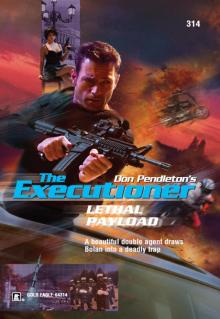 Lethal Payload
Lethal Payload Boston Blitz
Boston Blitz Knockdown
Knockdown Blood Sport te-46
Blood Sport te-46 Council of Kings te-79
Council of Kings te-79 Terrorist Dispatch (Executioner)
Terrorist Dispatch (Executioner) Silent Running
Silent Running Death Squad
Death Squad Deadly Salvage
Deadly Salvage Oceans of Fire
Oceans of Fire Teheran Wipeout
Teheran Wipeout Border Offensive
Border Offensive Devil's Horn
Devil's Horn Death Run
Death Run Continental Contract
Continental Contract Savage Deadlock
Savage Deadlock Eye to Eye: Ashton Ford, Psychic Detective
Eye to Eye: Ashton Ford, Psychic Detective Revolution Device
Revolution Device Heart to Heart: Ashton Ford, Psychic Detective
Heart to Heart: Ashton Ford, Psychic Detective Apocalypse Ark
Apocalypse Ark Texas Storm
Texas Storm Maximum Chaos
Maximum Chaos Sensor Sweep
Sensor Sweep Colorado Kill-Zone
Colorado Kill-Zone San Diego Siege te-14
San Diego Siege te-14 Tennessee Smash
Tennessee Smash Desert Impact
Desert Impact Fire in the Sky
Fire in the Sky Wednesday’s Wrath
Wednesday’s Wrath Super Bolan - 001 - Stony Man Doctrine
Super Bolan - 001 - Stony Man Doctrine Chain Reaction
Chain Reaction Pacific Creed
Pacific Creed Death List
Death List Rebel Force
Rebel Force Savannah Swingsaw te-74
Savannah Swingsaw te-74 Heart to Heart
Heart to Heart Shadow Search
Shadow Search Thermal Thursday
Thermal Thursday Battle Mask te-3
Battle Mask te-3 Rogue Assault
Rogue Assault Blind Justice
Blind Justice Cold Fusion
Cold Fusion Nigeria Meltdown
Nigeria Meltdown Backlash
Backlash Moscow Massacre
Moscow Massacre St. Louis Showdown
St. Louis Showdown Anvil of Hell
Anvil of Hell Life to Life: Ashton Ford, Psychic Detective
Life to Life: Ashton Ford, Psychic Detective Amazon Impunity
Amazon Impunity Run to Ground te-106
Run to Ground te-106 Save the Children te-94
Save the Children te-94 Detroit Deathwatch
Detroit Deathwatch Shadow Hunt
Shadow Hunt Terror Ballot
Terror Ballot Stand Down
Stand Down Dixie Convoy
Dixie Convoy Vendetta in Venice
Vendetta in Venice War Against the Mafia
War Against the Mafia Assassin's Tripwire
Assassin's Tripwire Appointment in Kabul te-73
Appointment in Kabul te-73 The Chameleon Factor
The Chameleon Factor Pirate Offensive
Pirate Offensive Prison Code
Prison Code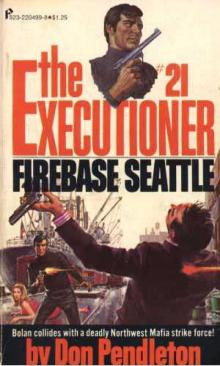 Firebase Seattle te-21
Firebase Seattle te-21 Ground Zero
Ground Zero Assassin's Code
Assassin's Code Perilous Skies (Stony Man)
Perilous Skies (Stony Man) Toxic Terrain
Toxic Terrain Canadian Crisis
Canadian Crisis Executioner 057 - Flesh Wounds
Executioner 057 - Flesh Wounds Uncut Terror
Uncut Terror War Everlasting (Superbolan)
War Everlasting (Superbolan) Nuclear Reaction
Nuclear Reaction Capital Offensive (Stony Man)
Capital Offensive (Stony Man) Beirut Payback te-67
Beirut Payback te-67 Monday’s Mob
Monday’s Mob Blood Dues te-71
Blood Dues te-71 Dead Easy
Dead Easy Texas Showdown at-3
Texas Showdown at-3 Sold for Slaughter
Sold for Slaughter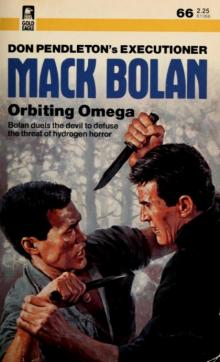 Orbiting Omega
Orbiting Omega Copp On Ice, A Joe Copp Thriller (Joe Copp Private Eye Series)
Copp On Ice, A Joe Copp Thriller (Joe Copp Private Eye Series) Rebel Blast
Rebel Blast Blowout
Blowout Killing Trade
Killing Trade Assault on Soho
Assault on Soho Season of Slaughter
Season of Slaughter Collision Course
Collision Course Shock Waves
Shock Waves Continental Contract te-5
Continental Contract te-5 Dead Reckoning
Dead Reckoning Enemies Within
Enemies Within Agent of Peril
Agent of Peril Death Has a Name
Death Has a Name Vegas Vendetta te-9
Vegas Vendetta te-9 The Fiery Cross
The Fiery Cross Cleveland Pipeline
Cleveland Pipeline Armed Response
Armed Response Mercy Mission
Mercy Mission Tiger War te-61
Tiger War te-61 Renegade Agent te-47
Renegade Agent te-47 Damage Radius
Damage Radius Eye to Eye
Eye to Eye Acapulco Rampage
Acapulco Rampage Skysweeper
Skysweeper The Iranian Hit te-42
The Iranian Hit te-42 Death Gamble
Death Gamble Rebel Trade
Rebel Trade Predator Paradise
Predator Paradise Battle Mask
Battle Mask Pulse Point
Pulse Point Missouri Deathwatch
Missouri Deathwatch Blood Tide
Blood Tide Missile Intercept
Missile Intercept Jersey Guns
Jersey Guns Hostile Force
Hostile Force The Bone Yard te-75
The Bone Yard te-75 Twisted Path te-121
Twisted Path te-121 Mind to Mind
Mind to Mind Copp On Fire, A Joe Copp Thriller (Joe Copp, Private Eye Series)
Copp On Fire, A Joe Copp Thriller (Joe Copp, Private Eye Series)